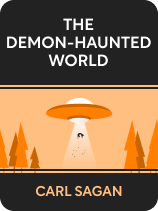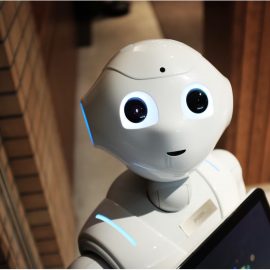

This article is an excerpt from the Shortform book guide to "The Demon-Haunted World" by Carl Sagan. Shortform has the world's best summaries and analyses of books you should be reading.
Like this article? Sign up for a free trial here .
What does Carl Sagan mean when he says that the world is “demon-haunted”? What does he recommend as a solution to this problem?
Renowned astronomer and science popularizer Carl Sagan believes the world is in a precarious position. Science has taught us a great deal about the world and brought about many beneficial changes to humanity, yet we still cling to unscientific beliefs and ideas at an alarming level. Sagan argues that, as we advance into the 21st century and beyond, our collective ignorance of scientific methods, values, and thinking may be catastrophic to us and the world we live in. In The Demon-Haunted World, he tries to counteract these dangers by teaching the scientific method and encouraging the application of critical and skeptical thinking in all facets of life.
Continue reading for an overview of The Demon-Haunted World by Carl Sagan.
Carl Sagan’s The Demon-Haunted World
Today, Carl Sagan claims, the dangers of a scientifically illiterate society are more drastic than ever before. Whether we like it or not, our world depends on science and technology in nearly every aspect of our lives. Medicine, agriculture, communication, transportation, the economic system, and virtually all other major industries rely on the knowledge and information gained by scientists. The average person, though, doesn’t understand how most of these things work at a fundamental level. This, according to Sagan, is a recipe for disaster. How, he asks, can we expect to make smart decisions about our future if we don’t understand the underlying concepts?
The Demon-Haunted World by Carl Sagan, first published in 1995, warns of a dark future: one in which people are largely ignorant of the world around them, we are unable to determine what’s true and what’s not, we are too quick to believe in the false or the supernatural, our lack of critical and skeptical thinking erodes our ability to adequately question authority, and we slowly devolve into a less prosperous and democratic society. Sagan wants to make the ideas and, more importantly, the methods of science more accessible to the average person. A citizenry that better understands the methods of scientific, critical, and skeptical thinking will be better equipped to tackle the challenges that face humanity in the 21st century.
The Principles of Science
According to Sagan, science, at its core, is about asking questions, sharing knowledge, testing ideas, and viewing everything with a critical and skeptical eye. It’s driven by a curiosity about the world around us—an attempt at understanding how the universe works. But, perhaps most importantly, science is about not accepting a claim to knowledge unless it can be proven, unless there is verifiable and reproducible evidence that confirms it to be true. Throughout history into the present day, we see how the failure to apply these principles can lead to disastrous consequences. Furthermore, the shortage of scientific awareness can be seen around the world in the widespread belief in the supernatural or mystical, the general acceptance of pseudoscientific ideas, and the espousing of anti-science rhetoric.
| Science as an Expert Consensus In Merchants of Doubt, Naomi Oreskes and Erik Conway give a little more insight into what science is and how it works. While some think the principles of science are more or less iron-clad, Oreskes and Conway argue that science is really more of an expert consensus on claims to knowledge. It is collaborative in nature, as reaching a consensus on a scientific question requires extensive research and peer review. One scientist comes up with a hypothesis, collects evidence, and publishes the findings. Other scientists, preferably experts in the same field, then examine the evidence and try to poke holes in the theory. Through this process, a consensus is reached, but just because a hypothesis is peer-reviewed and published doesn’t mean it is fact. There will always be at least a small degree of uncertainty in scientific matters. |
The Spread of Pseudoscience and Supernatural Beliefs
Sagan claims beliefs in pseudosciences are becoming more and more common in the modern age. A pseudoscience is an idea or system of explanation that claims to be scientifically true but is actually based on faulty premises or insufficient evidence. In other words, pseudoscience is misinformation disguised as science.
The supernatural, on the other hand, is something that exists outside the laws of nature. Supernatural beliefs often come in the form of religious ideologies.
Why They’re Dangerous
Sagan argues that supernatural and pseudoscientific practices and beliefs can cause considerable harm. As they become more widespread, so does our sense of credulity—our propensity to believe in things without proof. A credulous society will be less critical and less open-minded because most of us will simply believe what we want to believe. As we stray further from the field of science and become more comfortable with pseudoscience and superstition, we lessen our capacity to distinguish between fact and opinion and between what feels good and what’s true. In doing so, we impair our ability to make important decisions, both at an individual and societal level.
Antiscience Rhetoric
Science and reason have the ability to upend or throw into question conventional wisdom. New discoveries often challenge our cherished beliefs. For this and many other reasons, Sagan claims, science is often criticized by both the masses and the powerful few. Some of the criticisms of science are valid, but they don’t hold weight when more carefully considered. To follow are a few common critiques of science that Sagan addresses in The Demon-Haunted World.
Science Is Evil
People may criticize science as immoral or evil, pointing to the threats of climate change and nuclear catastrophe or the detrimental effects of technology. Though scientific advancements have indeed led to some negative consequences, Sagan argues that the good outweighs the bad.
Science Is Too Narrow, Restrictive, and Reductive
Because of its skeptical and critical nature, some may say science is too quick to rule out any sort of explanation without physical evidence. It constrains a vast world of possibilities into a much smaller world of provable reality. It sets limits on what we can and can’t do.
Science Changes Too Quickly
Just when we think we understand something about the world, scientists say this is no longer true. New discoveries are constantly being made that disprove a previously ironclad scientific theory.
We May Be Better Off Not Knowing
Some suggest we may be better off without some of the knowledge science provides. What if a major scientific discovery with profound implications completely unravels an otherwise orderly society? Is releasing this information necessary if it doesn’t benefit the general public?
How to Remain Critical in the Modern Age
Sagan argues that commercial culture discourages critical thinking. We’re constantly encouraged to buy things without thinking too much about what we’re buying or if the claims about the efficacy of the product are even valid. Commercial culture cultivates a general sense of credulity amongst the population, which is then used to feed you more baloney and extract more of your money.
The processes of science have a toolkit for skeptical thinking built in. Sagan recommends asking some questions aimed at fostering skepticism:
- Can a study be validated by other sources?
- Is the argument based on evidence or an authority?
- Can a hypothesis be disproved?
Common Fallacies
Sagan claims it’s just as important to understand deceptive or fallacious arguments as it is to understand a reasonable argument. Here are a few of the most common examples:
- Non sequitur: When the conclusion doesn’t logically follow from the premise of the argument. Many of the logical fallacies mentioned can be considered nonsequiturs.
- Ad hominem: Attacking the person making the argument rather than the argument itself. Essentially, this is resorting to name-calling instead of making an actual counterargument.
- Appeal to authority: When an opinion from an authority is used to support an argument
- False dichotomy: To only consider the two extreme sides of an argument when there are many more options
- Straw man: To distort or exaggerate an opposing argument to make it easier to attack
Social and Political Change Through Science
Sagan argues that, once you adhere to the scientific tenets of skepticism and critical thinking, you’ll probably extend these principles into the social and political sphere. In general, the more we learn about ourselves and the natural world, the more absurd and flawed the ideas of racism, misogyny, and nationalism seem. The more we share knowledge and information, the more we threaten those in power. The methods of science can be used not only to advance civilization but also to uphold the ideals of freedom and democracy.
Increasing Science Literacy
A key argument of The Demon-Haunted World is that a scientifically literate public will greatly benefit society. Therefore, Sagan argues we must increase awareness and appreciation of science in the education system and in the general public. We can do this by increasing public funding of scientific research, as well as by communicating the discoveries, principles, and wonders of science in the classroom.

———End of Preview———
Like what you just read? Read the rest of the world's best book summary and analysis of Carl Sagan's "The Demon-Haunted World" at Shortform .
Here's what you'll find in our full The Demon-Haunted World summary :
- Carl Sagan’s argument that a less scientifically-minded society is a less prosperous one
- Why you must remain critical and well-informed in an increasingly complex world
- The decline of educational standards in America and possible ways to reverse it






